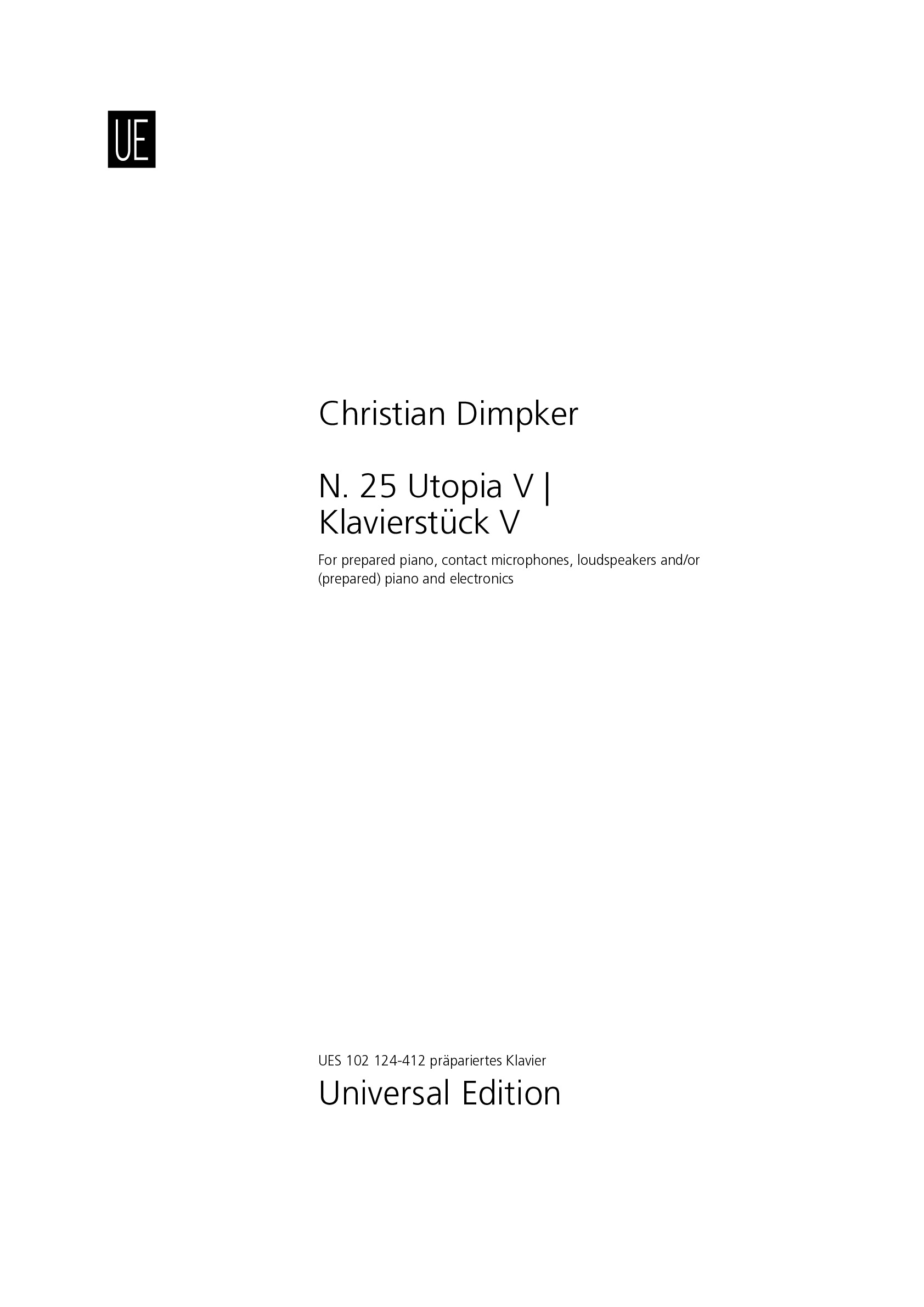

Christian Dimpker
N. 25 Utopia V | Klavierstück V
Duration: 18'
Solos:
prepared piano
N. 25 Utopia V | Klavierstück V
Translation, reprints and more

Christian Dimpker
N. 25 Utopia V | Klavierstück VOrchestration: Für präpariertes Klavier, Kontaktmikrofone, Lautsprecher und/oder (präpariertes) Klavier und Elektronik
Type: Noten
Sample pages
Video
Work introduction
The Utopia series stands for a reference to Berio, but also for the gradual disengagement of it. This was started with Utopia IV and is fully implemented with Utopia V. Utopia V is at the same time my Klavierstück V. The idea was to evade the obsolete sounds of the piano, but not to play its interior parts or prepare it in an invasive manner. Therefore, the preparation of the instrument is quite simple: heavy metal, stone and wood beams are placed on the strings. Depending on the piano model, the noise timbre varies. This is, in turn, dependent on the design of the piano. The beams are then picked up by means of contact microphones and sent directly to loudspeakers. The cover is (aside the contact microphones) used as an additional filter. The preparation enables the pianist to access a fresh, not yet worn-out soundscape. In order to transform Utopia V to Klavierstück V, the preparation is replaced by electronic modifications. The instrument is picked up and complemented by abstract (notated) electronic elements. Apart from that, the pianist plays the same piece. Finally, both pieces may also be merged; hence the prepared instrument is complemented by live-electronics. In total three versions (Utopia V, Klavierstück V and Utopia V/Klavierstück V) may be derived from the score.
What is necessary to perform this work?
Utopia V: As can be seen on the p. V, different materials are placed on the strings of the piano. The illustration is not exact. It refers to the Bechstein D 282. When applied to another model (with fewer crossbeams), the materials are supposed to be placed similarly at the pianist’s discretion. Hence the result may vary according to the model and interpreter. The utilised materials can be seen on p. V. A metal plate is placed partially under the bass strings, the other items are on them. The sand blocks may be ballasted. All materials are picked up by means of contact microphones (the long metal plate by two ones). When choosing the materials, consider that pitches should barley be perceived. The contact microphones need to work well when playing at low dynamic levels. The microphones are connected to the amplifier and send to the depicted loudspeakers (ad libitum with an additional convolution reverb - 2.5 sec. industrial hall). There is a switch left of the pedals that enables the pianist to turn the amplifier on/off with her foot (may also be realised in another way). The audience is sitting to the right of the pianist and hence looks into the open piano.
Klavierstück V: The non-prepared instrument is picked up by means of two cardioid microphones (ORTF, sampling rate 48 kHz) that are directed into the interior of the piano. The sounds are then transformed by means of the abstract (or: notated) electronics. This piece is not supposed to be performed, but is a studio work that may be played back through the loudspeakers inside the prepared piano with depressed pedal (while the pianist may release and depress at her discretion).
Utopia V | Klavierstück V: Both pieces are combined. This means that the prepared piano is picked up by the contact microphones and the cardioid microphones. Additionally, the electronics – except transposition and micro(montage) – are applied to the signal picked up by the ORTF set up and sent to two additional loudspeakers outside the piano. The copy of Klavierstück V is also played back through these speakers (see p. 7). The dynamic level of the electronic modifications is a little lower than that of the original signal. The framework of the electronics is created when working with Klavierstück V, but the pianist can then handle it freely (and does not have to adjust to the rigid tempo). This applies accordingly to the copy, the pianist’s playing should be deliberately displaced to it. Moreover, the the electronics dominate the piano sound in the concert hall, while the copy is, at most times, the lowest signal of them all (the dynamic levels can be handled flexibly).
